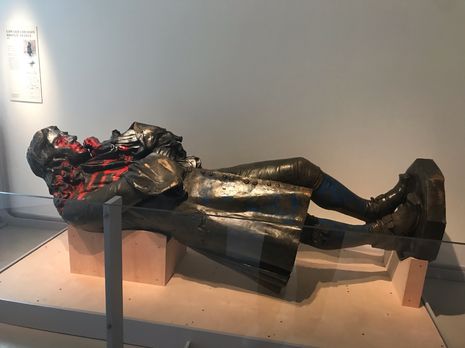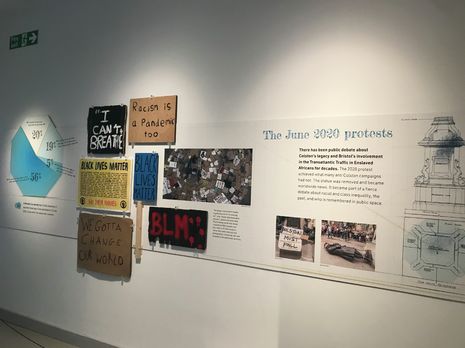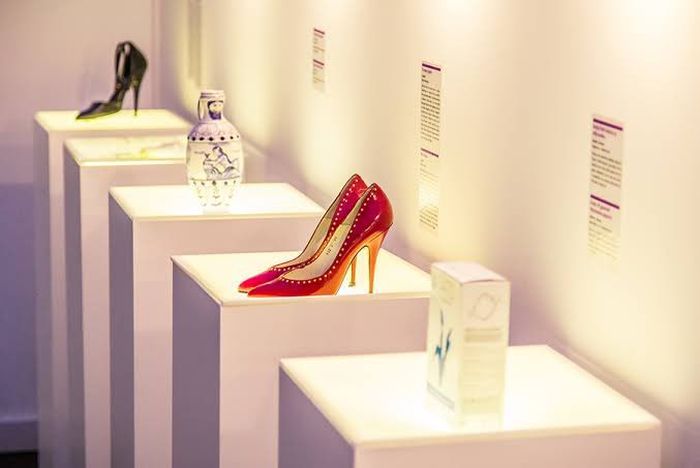“Totems of Power”: The Colston Statue Exhibit
Arts Editor Famke Veenstra-Ashmore visits Bristol’s M Shed, where they currently have an exhibition featuring the graffitied and dismantled statue of slave-trader Edward Colston.

Content Note: This article contains discussion of death in the context of the slave trade, and brief discussion of the murder of George Floyd.
The Edward Colston statue has almost an eerie presence – old photos of it highlight the statue’s looming height and triumphant stance upon both a literal and figurative pedestal. It was a constant reminder of his essentiality in founding Bristol for many, yet simultaneously a disturbing reminder of the black lives exploited and taken in the process. Not from Bristol myself, I didn’t even know the statue existed until it was thrown into the harbour, something that millions of us witnessed on the news during June of last year. It now lies on the floor of a cultural and historical people’s museum, the M Shed, with only a small plastic barrier and some graffiti spelling ‘BLM’ to keep it company – a perpetual reminder that black lives are, and will always be, far more important than the fate of any statue. Left in Bristol’s waters for four days prior to being rescued, many felt that its new pedestal – the bottom of this estuary – was fitting. His statue, the preservation of his life and memory, found the same fate of the millions of black people killed through the slave trade, evoking a strong sense of justice.
“Many felt that its new pedestal – the bottom of this estuary – was a fitting form of poetic justice”
Designed by sculptor John Cassidy in 1895, the statue was erected by the city in order to celebrate a man who brought much economic prosperity to Bristol. His slave trade origins were largely ignored, hidden by a veneer of bronze. Despite increasing controversy around its existence in the 1990s, and the lack of transparency around his activities, no acknowledgement was made to his role in the slave trade until 2018 when the plaque was updated. Still, the wording remained vague, and failed to adequately condemn his actions. The change was clearly performative, and did little to educate the masses on the true identity of the man. It’s no surprise to me then that the people of Bristol took matters – literally – into their own hands, and toppled the statue as a reaction to the killing of George Floyd and as a part of the Black Lives Matter protests which took place over that summer. The public removing a piece of art originally instated by a past, distant public, while unconventional, was an extremely creative way of sending a message to the rest of the public and the political elite – Bristol was no longer going to tolerate the glorification of such a man.

The exhibition itself was surprisingly short – it was clear that the statue was its focal point. Alongside the statue was a timeline of Colston’s legacy in Bristol, starting with his birth, and ending with where he’s ended up – with an open-ended question about the future. Brief explanations of the 2020 protests were accompanied by picket signs with quotes such as “racism is a pandemic too” – things that have become artefacts in their own right. A projector played a video with footage from the protests, alongside interviews and testimony from protestors and political figures, which will not only prove significant in their chronicling of history but are additionally great signifiers of cultural change. Overall, the exhibition was very succinct, bright and and clean – I think the goal of the exhibition is to provoke thought and opinion rather than to overload you with information – yet it remained educational and unafraid to present Colston for what he was, in a way which the statue and his false legacy had previously made impossible.
“It is entirely possible for us to preserve the memory of Colston and his actions without glorifying him”
While it is essential to chiefly look at the statue and its removal from a political point of view, it is also interesting to consider what this means for statues as an art form in the future. Innately, statues are a form of public expression and consumption, created to preserve the legacy of a deeply influential figure, or symbol. However, historically, they have been erected with the intention to glorify and immortalise a figure. In my view, the argument that the Colston statue, alongside other statues of controversial figures, should remain, confuses the act of remembering with the act of glorification. It is entirely possible for us to preserve the memory or history of Colston and his actions without glorifying him. The most famous statues – such as the Statue of Liberty – don’t represent people at all, but rather ideas, notions, themes. The problem with the Colston statue is that while acting as a historical reminder, it signifies concepts of white supremacy and the global oppression of minorities. We can’t glorify his life without glorifying his role in the slave-trade, hence why I believe that the statue should not be displayed as a symbol of pride in our current society. There are other ways of preserving and learning from the history and culture of the city, which the M Shed exhibition considers in its display.
Placing the Colston statue in the M Shed, where adequate context and scrutiny can be performed, is in my opinion, a good use of this outmoded artefact. In a place like this, it can be re-contextualised, and its significance and symbolism altered. It will remain both a stark reminder of how Bristol became prosperous – through oppression and slavery – but moreover of how the public harnessed their own power in 2020 to take direct action against racism and the glorification of slave-traders. As the historian David Olusoga has argued, statues when displayed publicly are “totems of power” but with the statue’s migration from pedestal, to harbour, to museum, “it’s now [become] a historical artefact and it has multiple meanings and multiple layers to it”. Observing the statue for myself in person, not only increased my awareness of of the Atlantic slave-trade generally, and its role in the UK, but also allowed me to see, first-hand, the importance of direct action and how critically we need to reassess the way we use art to preserve and remember historical figures.
‘The Colston statue: What’s next?’ exhibit is open to the public, for free, at the M Shed, Bristol, from 4 June to 5 September 2021.
 Comment / Cambridge’s tourism risks commodifying students18 April 2025
Comment / Cambridge’s tourism risks commodifying students18 April 2025 News / Cambridge student numbers fall amid nationwide decline14 April 2025
News / Cambridge student numbers fall amid nationwide decline14 April 2025 News / Greenwich House occupiers miss deadline to respond to University legal action15 April 2025
News / Greenwich House occupiers miss deadline to respond to University legal action15 April 2025 Comment / The Cambridge workload prioritises quantity over quality 16 April 2025
Comment / The Cambridge workload prioritises quantity over quality 16 April 2025 Sport / Cambridge celebrate clean sweep at Boat Race 202514 April 2025
Sport / Cambridge celebrate clean sweep at Boat Race 202514 April 2025






